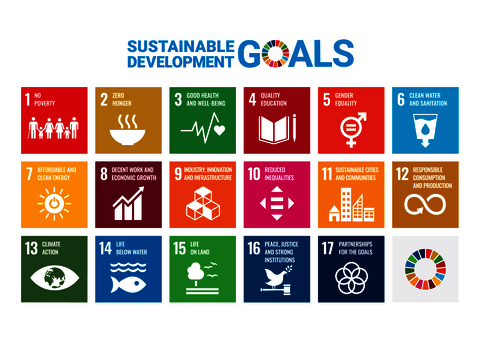The 2030 Agenda and its 17 Sustainable Development Goals
The 2030 Agenda for Sustainable Development was signed by 193 heads of state and government from around the world at the United Nations summit on 25 September 2015. At the heart of the agenda are the 17 Sustainable Development Goals (SDGs for short). Among other things, these seek to end hunger and poverty, tackle inequalities, promote prosperity for everyone, make lifestyles around the world sustainable, respect the earth’s planetary boundaries, protect human rights and establish global partnerships, all by 2030. The 2030 Agenda is thus a global contract for the future.
The 2030 Agenda also marks an important change in perspective. It combines economic, environmental and social development aspects, obliges all the countries around the world equally and underscores the joint responsibility of all the stakeholders – in politics, business, science and civil society as well as all of us as individuals.
The 17 SDGs are each made up of a varying number of targets, of which there are 169 in all. The preamble lists five principles – the “5 Ps” – which should drive implementation: people, planet, prosperity, peace and partnership. Their purpose is also to highlight the correlations between the various SDGs.
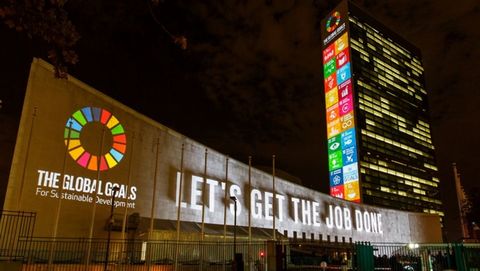
When the 2030 Agenda was signed, it was decided that the SDGs should be adapted and implemented at the national level. A national sustainable development strategy therefore serves as a key instrument in Germany and in many other countries. A government is unable to handle the implementation process on its own, however – those with political responsibility at the subnational level must do their bit too. Thus, strategies at the Länder level and solutions at the municipal level have an important role to play in Germany. Additionally, every government is required to facilitate comprehensive and responsible dialogue among all the stakeholders.
The German Sustainable Development Strategy
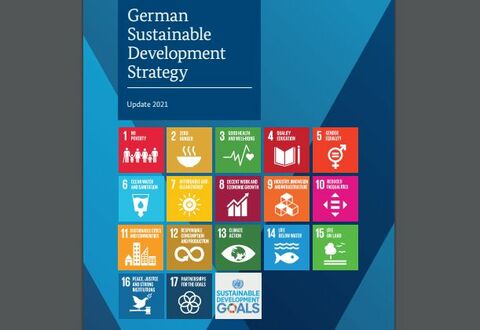
Germany has pledged both to implement the 17 global Sustainable Development Goals (SDGs) of the UN’s 2030 Agenda for Sustainable Development within its own country and to support other countries in their efforts to do the same. The German government’s Sustainable Development Strategy lays the foundations to achieve these goals. An initial sustainability strategy was first adopted in Germany in 2002 and was later aligned with the 2030 Agenda when the international community adopted the latter with its 17 global goals in 2015. The Strategy sets out specific targets and indicators for each SDG to monitor implementation.
As sustainable development is an ongoing task, the German government revises its Sustainable Development Strategy every four years, most recently in March 2021. This time round, the Strategy was fundamentally overhauled, identifying for the first time six areas of transformation which each address a number of SDGs simultaneously:
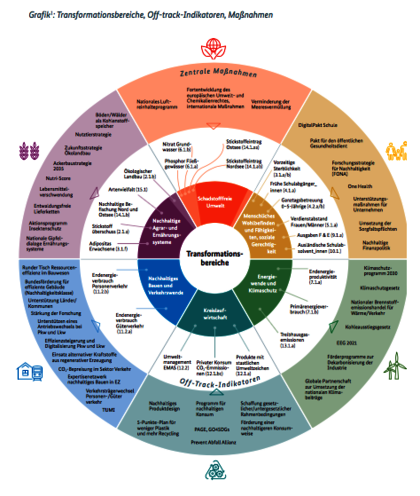
1. Human well-being and capabilities; social justice
2. Energy transition and climate action
3. Circular economy
4. Sustainable building and the transformation of transportation
5. Sustainable agricultural and food systems
6. Pollutant-free environment
This identifies the key areas that together encompass core global challenges and require a systematic political approach.
Also new in the German Sustainable Development Strategy are the off-track indicators, which highlight where targets are not likely to be met by 2030.
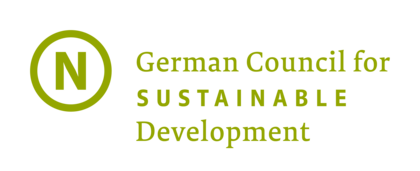
The German Council for Sustainable Development (RNE) has been involved in the ongoing development of the German Sustainable Development Strategy since it was first published in 2002. The Council consists of 15 public figures. The Council’s tasks include generating contributions to the German Sustainable Development Strategy, specifying concrete fields of activity and projects and also providing contributions that make sustainability a public issue of vital importance. The RENN network is likewise coordinated nationally by the RNE Office.
The revised 2016 version of the strategy introduced important dialogue formats designed to promote nationwide exchange and collaboration among the various stakeholders and advance implementation of the strategy. These include the Sustainability Forum, which promotes exchange between the German government and central social actors, and the Science Platform Sustainability 2030, which aims to amplify the voice of science in sustainability policy and drive the implementation of the 2030 Agenda.
The Sustainable Development Strategies of the Länder
The Länder have an important part to play in the German Sustainable Development Strategy. The federal government and the Länder regularly discuss the latest sustainable development issues via the so-called Bund-Länder-Erfahrungsaustausch zu nachhaltiger Entwicklung (exchange of experience between the Federal Government and the Länder on sustainable development), which is chaired by the Federal Chancellery and by the chairing federal state of the Conference of Minister-Presidents. Germany's federal structure means the realisation of important goals, such as education, is the responsibility of the individual Länder. It is up to those responsible at the regional level to decide how these goals are achieved. The majority of the Länder draw on an overarching sustainable development strategy here.
The joint federal government and Länder declaration “Gemeinsam für eine nachhaltige Entwicklung – in Verantwortung für eine gute Zukunft in Deutschland, Europa und der Welt” (Working Together for a Sustainable Future – Assuming Responsibility for a Good Future in Germany, Europe and the World) published in June 2019 represented an important milestone in federal–state cooperation. This established that political activities at the federal and state levels should be guided by the principles of sustainable development as set out in the German Sustainable Development Strategy, which underscore the shared concern of the federal government and the Länder that sustainable development be a joint effort.
Baden-Württemberg
Baden-Württemberg has set out to anchor ‘sustainability as the state’s trademark’. To this end, the Land government launched its own sustainability strategy back in 2007 called “N!-Strategie (S! Strategy)”. The strategy, which is updated on a regular basis, creates a platform for the Land, local government, business and society. Where the strategy currently stands and the progress it has made are published in a cross-departmental sustainability report and every two years in an indicator report. Since 2019, the latter has been based on the 17 global Sustainable Development Goals.
- The Land’s current focus is on climate and energy, sustainable consumption, education for sustainable development and sustainable production.
- Target-group-specific initiatives support sustainable development in local governments and business and help to get young people involved.
- Stakeholder dialogue events held on “Living well sustainably” and “Sustainable digitalisation” aim to shape a broad range of opinions on current affairs.
- Sustainability Advisory Committee working groups kick-start projects and develop recommendations and statements.
- The Ministry of the Environment, Climate Protection and the Energy Sector Baden-Württemberg alongside the Office of the Sustainability Strategy are taking the lead here.
Bavaria
The current Bavarian Sustainability Strategy (de) was adopted in October 2017. The strategy is not intended as a finished product, but rather as the basis for a sustainable social and political process. As such, the strategy is under ongoing development. Among other things, the update will include the results of the 2018 citizens’ survey entitled “2030. BAYERN, DEINE ZUKUNFT (2030. BAVARIA, IT’S YOUR FUTURE)”.
- Bavaria’s strategy includes 11 goals which correspond to, and aim to realise, the 17 global SDGs from the UN’s 2030 Agenda.
- The focus is on climate change, sustainable energy, natural resources, sustainable mobility, social cohesion, education and research, the green economy and sustainable consumption, nutrition, health, care, state and administration, sustainable financial policy and finally global responsibility and networking.
- The Bavarian State Ministry of the Environment and Consumer Protection is responsible for the strategy.
Berlin
At present, the Land of Berlin does not have a sustainability strategy in place.
Brandenburg
The Brandenburg Land government adopted its “natürlich.nachhaltig.Brandenburg (natural.sustainable.Brandenburg)” strategy back in 2014 following public engagement. The government later updated the strategy in 2019, making it more specific and aligning it with the 17 SDGs.
The goals set out apply to the Land’s government, but also to local government, organisations and individuals.
- Brandenburg’s strategy consists of 17 goals and 33 sub-goals that span all social issues: eradicating poverty, nutrition, health, education, equality, environmental and climate protection, decent work, peace and justice. The goals also include indicators, making it clear where the Land of Brandenburg stands and where it aims to go.
- The focus is on business and work in the Berlin-Brandenburg capital region, liveable towns and cities, Brandenburg as a model region for the energy transition and climate adaptation, sustainable financial policy, education and the environment.
- The State Chancellery of Brandenburg, specifically the department for Government Planning, Capital Region Coordination and Regional Development, is responsible for the sustainability strategy and the Sustainability Advisory Committee. The Ministry of Agriculture, Environment and Climate Protection (de), specifically the Climate Protection & Sustainability department, is responsible for more general issues relating to sustainable development.
Bremen
At present, the city-state of Bremen does not have a sustainability strategy in place.
Hamburg
In 2017, the Hamburg Senate (de) adopted a roadmap, publishing the document “Umsetzung der Nachhaltigkeitsziele der Vereinten Nationen in Hamburg (Implementation of the United Nations Sustainable Development Goals in Hamburg)”. The document both takes stock of where the Senate stands – Where does the Senate’s policy already correspond to the goals of the 2030 Agenda – and sets out focal points and future development.
- The focal points fall on the environment and the city, sustainable economic and financial policy, engagement and social cohesion, and education and science.
- Individual projects include for example Oberbillwerder, in Hamburg’s east, where the aim is to showcase how integrated urban development works. Hamburg is also making its buying greener and greener, with the city’s buyers factoring sustainability into their choice of products and services. Disposable tableware and chlorine cleaning products are all banned, for example. Events on city-owned land are also becoming increasingly sustainable and alongside ambitious climate protection targets for the city as a whole, Hamburg is also striving to achieve climate neutrality for its own state administration by 2030.
- Leading the way: a cross-authority SDG working group is acting as a coordinating body, representing all relevant authorities. The Sustainability Forum Hamburg (NFH), an alliance of more than twenty civil society organisations, is monitoring the sustainability transition.
Hesse
Hesse’s sustainability strategy celebrated its tenth anniversary in 2018, with Hesse’s Land government taking the opportunity to have external sustainability experts evaluate the Land’s work to date in a peer review from which they developed recommendations for the future.
- Hesse’s strategy consists of 13 goals that align with the United Nations’ 17 global SDGs, while Hesse’s sustainable development progress is regularly reviewed on the basis of pre-defined indicators.
- The strategy focuses on education for sustainable development, biodiversity, climate protection and climate change adaptation, sustainable lifestyles, sustainable consumption and ensuring that sustainability as a concept is clearly understandable for all people in everyday life.
- The Sustainability Strategy Office (de) in the Hessian Ministry for the Environment, Climate Protection, Agriculture and Consumer Protection is responsible for this.
Lower Saxony
Lower Saxony anchored sustainability as a policy issue as early as the 1990s, with the first sustainability strategy, “Umweltgerechter Wohlstand für Generationen (Environmentally Sound Prosperity across the Generations),” published in 2008. In 2017, the strategy was updated, and the Land government adopted the “Nachhaltigkeitsstrategie für Niedersachsen (Sustainability Strategy for Lower Saxony)” based on the 17 global SDGs. The strategy sets out 26 action points with a total of 60 indicators. 2020 saw the strategy’s progress evaluated for the first time and later published in a report. In parallel, the Land strategy widened socially towards local government and economy.
- Lower Saxony’s strategy has three focal points: “Economic Performance”, “Social Cohesion” and “Protection of Natural Resources”. Each of these three focal points has between eight and ten assigned action points.
- The action points include, for example, sustainable financial policy, securing skilled workers, securing social cohesion, integrating migrants, sustainable urban development and housing policy, sustainable agriculture, resource conservation, and sustainable energy supply.
- Responsibility is borne by the Lower Saxony Ministry for the Environment, Energy, Building and Climate Protection.
Mecklenburg-Western Pomerania
Mecklenburg-Western Pomerania has centred its strategy for the future around the 17 global UN Sustainable Development Goals. In spring 2021, the Council for the Future, an honorary body of 49 public figures, set out a series of recommendations entitled “Unsere Zukunft ist jetzt – Für ein nachhaltiges, digitales und gemeinwohlorientiertes MV (Our future is now – for a sustainable, digital MWP focused on public welfare)”. This work has also included ideas from the “MV 2030 mitdenken (Shaping MWP together for 2030)” online civic engagement event. The government, parliament and civil society in Mecklenburg-Western Pomerania are now all working together to develop steps to implement this.
- The Council for the Future recommends 3 courses of action: making sustainability a binding criterion for political and institutional action, accelerating the expansion of digital infrastructure and digital engagement, and centring the common good as the guiding principle behind services of general interest.
- Action points include: the expansion of renewable energies, implementation of sustainable land use in agriculture, forestry, energy and tourism, stabilisation of the region’s water supply, further development of interdepartmental education for sustainable development and the establishment of a climate-neutral state administration.
- Responsible body: State Chancellery of Mecklenburg-Western Pomerania
North Rhine-Westphalia
In 2016, the Land’s government adopted a sustainability strategy for North Rhine-Westphalia. The Strategy was developed in cooperation with local government, civil society, politics, business and science and made NRW the first German Land to commit to implementing the global SDGs from the UN summit in New York in September 2015. The Sustainability Assessment for Laws and Ordinances, which is based on the goals set out in the Strategy, is a key instrument here. In 2020, the Land government adopted a further stage of the strategy: “Die globalen Nachhaltigkeitsziele konsequent umsetzen (Systematically Implementing the Global Sustainable Development Goals)”.
- At the core of the sustainability strategy is a set of 67 specific goals and indicators which are closely linked to the national goals and based on the global SDGs. Ecology, the economy and social cohesion all bear equal weighting.
- The strategy focuses on 14 particular challenges posed by sustainable development for NRW in terms of Land policy and explains how they can play a role in achieving the goals set out in the 2030 Agenda. The strategy is supplemented by NRW sustainability reporting via the www.nachhaltigkeitsindikatoren.nrw.de portal.
- The Ministry for Environment, Agriculture, Conservation and Consumer Protection of the State of North Rhine-Westphalia is the responsible body.
Rhineland-Palatinate
Rhineland-Palatinate has long been a leader in sustainability, with the Land’s government calling on the federal government as early as 1999 to report every two years on the progress in implementing the resolutions made at the 1992 UN Environment Summit in Rio de Janeiro. The first Sustainability Strategy (de) was published in 2001 and has been systematically developed ever since. More recently, it was aligned to fit the 17 SDGs.
- The strategy is based on the six principles agreed between the federal and Länder governments: apply sustainability as a guiding principle, assume global responsibility, preserve the natural basis of life, strengthen sustainable economic activity, maintain and improve social cohesion in an open society, and use education, science and innovation to drive sustainable development.
- Priorities include reducing greenhouse gas emissions, increasing resource efficiency, expanding organic farming, reducing the risk of poverty, and education for sustainable development.
- The State Chancellery bears responsibility.
Saarland
2016 saw the Saarland Land government adopt the “Gemeinsam Verantwortung tragen – für heute und morgen (Taking responsibility together – for today and tomorrow)” sustainability strategy, based on the 17 SDGs. In 2020, the decision was made to continue the strategy as a participatory project with widespread citizen dialogue under the slogan “Wir gestalten gemeinsam. Saarland nachhaltig (Co-creating a sustainable Saarland)”.
- The strategy consists of 6 action points, namely “Education, knowledge, innovation”, “Financial sustainability”, “Demography, sustainable residential development”, “Climate and resource protection”, “Preservation/strengthening as an economic and industrial location” and “Mobility”.
- Goals include “Further expanding education in the spirit of sustainable development”, “Promoting the integration of those with a background of migration” and “Reducing greenhouse gas emissions”.
- The responsible body is the Ministry of the Environment and Consumer Protection (de). The sustainability strategy is currently being updated, with widespread civic engagement and a focus on specific sustainability projects
Saxony
The Saxon Land government adopted the “Nachhaltigkeitsstrategie für den Freistaat Sachsen 2018 (2018 Sustainability Strategy for the Free State of Saxony)” in 2018. The strategy was jointly developed by all the ministries and encompasses the economic, ecological and social dimensions of sustainable development, giving equal weighting to each. The 2018 strategy follows on from the 2013 sustainability strategy and takes into account the global UN Sustainable Development Goals with targets in place for 2030. The strategy includes responses from a whole number of citizens, associations, companies and institutions in the spirit of public engagement.
- Saxony’s strategy is made up of nine deliberately cross-departmental action points.
- The action points are education and science, public finances, energy and climate, natural resources and resource conservation, cities and rural areas, economy, innovation and skilled labour, health and quality of life, cultural diversity, social cohesion and equal opportunities, international relations and collaborative development.
- Coordination falls to the Saxon State Ministry for Energy, Climate Protection, Environment and Agriculture (de), while implementation is up to the departments.
Saxony-Anhalt
The Land government of Saxony-Anhalt first adopted a sustainability strategy in 2011, before aligning it in 2018 with the 17 global Sustainable Development Goals. The strategy states: “Every resident of Saxony-Anhalt should be able to answer future generations knowledgeably and in good conscience when asked ‘What did you do back then to positively shape the future of our planet?’”
- Saxony-Anhalt’s strategy covers a number of action points: financial policy, demographic change, health, social security and eradicating poverty, economy, labour market development, rural development, digitalisation, environmental alliance, climate and energy, education and science, development policy guidelines and sustainable development education.
- Priorities include reducing the number of people at risk of poverty, expanding organic farming, reducing smoker numbers, improving energy efficiency, expanding renewable energies and transforming forests into mixed woodlands.
- The Ministry for the Environment, Agriculture and Energy (de) is the responsible body.
Schleswig-Holstein
In March 2016, the Schleswig-Holstein State Government made the decision to implement the 2030 Agenda at Land level. In 2020, the government published the “1. Bericht Schleswig-Holsteins zu den UN-Nachhaltigkeitszielen (First Schleswig-Holstein Report on the UN Sustainable Development Goals)”, bringing transparency to where sustainable development stands with indicators and target markers. This report also forms the basis for future action, as development in the Land is measured every five years and evaluated using 75 indicators to establish where there is a need for action and identify relevant measures. The Land strategy for education for sustainable development (ESD) anchors learning in the spirit of ESD across all areas of education, points on the learning journey and in the Land administration’s initial, ongoing and advanced training programmes.
- Schleswig-Holstein’s sustainability report draws on the 17 UN SDGs to create eight action points for the Land.
- The focus is on good governance and social engagement, healthy living, education, social justice, infrastructure and climate protection, sustainable management and resource conservation, safeguarding of natural resources and global responsibility.
- The Ministry of Energy, Agriculture, the Environment, Nature and Digitalization and the State Chancellery are jointly responsible.
Thuringia
Thuringia’s latest sustainability strategy was adopted in August 2018 and follows on from its first strategy from 2011. It is now based on the 17 SDGs and incorporates the results of discourse with a broad section of civil society.
- Thuringia’s strategy includes 5 priorities: “Education and lifelong learning”, “Climate, energy and sustainable mobility”, “Sustainable consumption and business”, “Biodiversity protection” and “Reducing inequality”.
- Goals include “Maintaining high-quality all-day care for preschool children” and “Reducing the level of debt per resident”, as well as reducing childhood obesity and promoting local public transport, organic farming and renewable energies. Equally, biodiversity promotion is important as well as reducing nutrient discharge in waterways.
- The Thuringian Ministry of Environment, Energy and Nature Conservation is the responsible body.
For further information on the sustainability strategies of the individual German Länder, please visit the German federal government website: Länder und Kommunen (bundesregierung.de) (in German).


